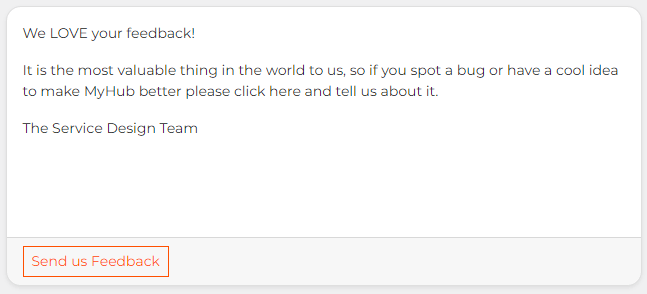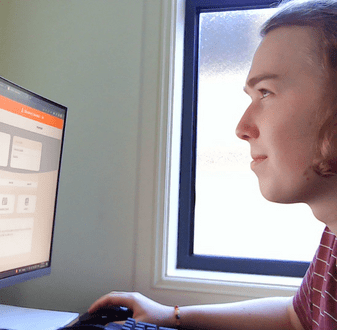Students entering higher education for the first time are overwhelmed with competing priorities, from onboarding to systems and subject selection to timetable management and engaging with course content.
At Torrens University Australia, the cognitive load issue has been addressed head-on. Introducing MyHub - a personalised digital experience defined and designed in collaboration with students.
"The beauty of MyHub, from a technical perspective, are the integrations we have developed to allow it to access the various other systems students currently use. This means we can cherry-pick only the most valuable information from each to display to students," said Negar Hamid, Digital Product Manager - CX.
MyHub has seen significant adoption from students, despite still being in a proof of concept (POC) phase of development and no formal communication of its existence being released.
"You know you are onto something special when you see user numbers growing through nothing more than word of mouth," said Tomas Haffenden, Head of Service Design.
Students have discovered MyHub organically, been impressed enough to return, and spread the word to their peers. It showcases what successful engagement looks like and demonstrates an enhancement to the student experience.
"The first week, we saw 7000 visits, and this has now grown to 16,000 students, which is very exciting. Even better, 85% of them are returning to MyHub more than three times a week," said Negar.
Never Assume…
The genesis of the MyHub project was a need to move beyond a generalised approach to data and explore what students themselves wanted to see and interact with. This was a significant undertaking that required numerous feedback sessions where students were front and centre in the discovery process.
"We built the best product we needed to put students right at the heart of things and be open to the changes that often challenged the status quo," Negar explains.
Every assumption was explored and challenged by a cross-functional team that included students at every stage.
"It is critical that students are front and centre. They are the user. Do we know what they want? No, we don't, so we need ask them!" said Tomas.
Defined by students, designed by students
The Service Design department hand-picked several students to join the core team for this project, to provide not just student insight but contribute tangible skills from their area of study, Graphic design, UX/UI and Computer Science.
The plan was to take the student experience from reactive to proactive by using service design methodology to design a simplified digital platform to access their numerous learning and administration platforms and therefore revolutionise the student experience.
"It's been amazing. The students have introduced a new perspective to the project, which we never had previously. It was a great opportunity for us," said Negar.
The three final-year students selected were Ahmad Hussein - Bachelor of UX & Web Design, Alexandra Baguely - Master of Design, and Joel Bowman - Graduate certificate of UX and UI. Joel has most recently accepted an offer to join the team permanently after graduating.
"Something I've really loved about this role is that I felt heard. The first day I was interviewed, I said, 'hey, from my personal view, I disliked this thing on the student hub,' I came back the next day, and it was fixed!" said Joel.
"I thought this is actually good, they're really listening. I have an opportunity here to kind of improve student life."
Focus on function and keeping it personal
The challenge, or rather, opportunity, was to find an elegant way to integrate with multiple unconnected disparate systems, each with individual logins, then cherry-pick the high-value information from the student ambassador research team.
According to Joel, excellent user experience (UX) is about finding solutions to user problems. It's about meeting a user's needs, and the user interface (UI) is the design that solves the problem. Creating a better experience for the students is a clear driver for Joel and the Service Design team.
"I like UX, I like talking to people. I like getting feedback and then presenting the solution. Don't get me wrong, I love designing pages, it just doesn't have that same kind of interaction or that direct feel of helping someone."
According to Tomas, students should spend their time at university expanding their minds pertinent to their degree, not navigating a minefield of UX/UI experience to access the information they need.
"Anything we can do to reduce that load is important. Why are there ten steps if we can find a way to do it in one?" said Tomas.
"As a student, I want to spend my time at a uni studying. I don't want to spend it doing unnecessary administration," Joel said. "It was a shot in the dark sometimes and MyHub is a solution to that. It tailors this experience, and it directs me to where I need to go."
With a focus on functionality, MyHub alleviates the stress by allowing a student to log in once with a single-entry point to see a personalised dashboard in a clear, concise and easy-to-access manner providing consistent student support from day one through to graduation.
Students can now find all of their essential information, including timetables, grades, assessment and assignment dates, and contacts, in one place, seamlessly linking to associated systems without a second sign-on.
"To be very honest, our focus has been functionality over design. For now, we intentionally kept everything pretty simple design-wise. I'm a big fan of simplicity and avoiding needless content where we can," said Negar.
"Personally, functionality has to come first, right? If it doesn't work, I don't care how it looks. At the moment, I think it's hitting that nice balance where it's functional and clean," Joel agrees.
MyHub also addresses another frustration for students and staff alike - forms. Being able to securely map student data from the CRM (Customer Relationship Management) to all available form fields means that every document opens will all known data. For some documents, this can be as much as 70% of the requested fields.
"My visceral hatred of forms drove our focus on that area. We were committed to intelligent automation to streamline the student experience at every step," said Tomas.
"This shift changes the experience from an annoying and repetitive task of filling out information the students are aware we already know into a surprise and delight moment of recognition that we, as a business, value them and their time," adds Tomas.
Beyond the evident enhanced experience provided by self-service and auto-filling information already in the system, the wider business has benefited from increased data integrity, tracking and reductions in processing times, in turn gifting thousands of hours of people power back into the business.
The holiday letter is an example of a form which is now self-service on demand via MyHub and fully automated, resulting in less error and a tighter turnaround time allowing international students more hours to work during their breaks from study.
"The height of bad customer service is requesting information from a customer you should already know," said Tomas.
And it is smart and personalised. The holiday letter is only required for international students, meaning this option isn't presented for a domestic student's login.
"To me, I guess it's the standard that everything's personalised in life now, everything's tailored to the individual, and that's what MyHub is all about," said Joel.
"It's about bringing the information to the students that they need and removing a lot of the clutter out there that isn't all relevant to each student. In fact, most of it isn't."
Asked if there's a section he is most proud of, it's hard to pick favourites.
"My favourite part about it is that it's accessible and students need it. It's something that is making students' lives better every day, and that's what's important to me. So, I can't narrow it down to one thing."
Circular feedback creates constant improvement
So, does MyHub solves all the previous challenges? Joel says they're getting there, and that's largely due to a circular feedback loop with the students who have discovered the platform's invitation to feedback.
Tomas says the reactive feedback loop is a valued open channel of communication for users, and essential in improving this platform.

Pioneer users of MyHub are greeted with a message; 'We LOVE your feedback! It is the most valuable thing in the world to us, so if you spot a bug or have a cool idea to make MyHub better please click here and tell us about it.'
This prompting of the user to elicit desired behaviour resulted in an unprecedented amount of positive feedback further reiterating the value of MyHub in the eyes of students. 'This is brilliant, so easy to use!', 'I love this!!! It is functional and clear', 'This is awesome! I love this', 'Where was this in year one!? Legends!' and 'This has made my life better'.
For Joel it's the negative feedback that fires his interest. He enjoys that challenge.
"Absolutely. Well, I mean, I'm not going to learn if everyone tells me everything's great all the time. Let me learn why what we did is not helping you."
"We're excited to keep adding things that hopefully continue to enhance the student experience," said Joel. "It's a project that we have the capacity to evolve, and we have big plans for it."
"The students obviously understand that we reply to them, we're here for them, and we action things. This is amazing. It shows they've realised we're listening and responding," said Negar.
Currently, Tomas is replying with a personalised response to each feedback provider enabling the collaborative nature of this ongoing project. He's responded to 200+ so far.
And it's not all about accessing crucial information; there's always room for fun. Tomas has included in his words "a few easter eggs" for the students. For example, if a student logs in on their birthday a message from Tomas singing Happy Birthday will pop up.
There's no I in team
"We all work so collaboratively," said Joel of the four-person team servicing 20,000 students' unique needs.
"Being in a team specifically, this team has is incredible. There is no hierarchy. We're constantly looking for the best ideas, and it doesn't matter who has those ideas."
Coming into his first professional role, Joel expected a very formal environment, but it hasn't been that experience. It's relaxed, trusting, and respectful of each other's knowledge.
"I thought coming in as a student I would be treated as a junior member, but in fact my voice is as strong as ever, and I think it's important that I keep speaking up and don't lose that voice."
Writing a blueprint for student progression
"The most important thing from a product management perspective if you have a product that needs to be successful and if no one's really using it then it's a failure, right? So, if you want it to be successful, you need to design it for the people who are using it, and what better way than getting them in there designing," said Negar.
Negar said the opportunity to work with our students directly was, and continues to be, a privilege.
"Having them on the team is the secret sauce of MyHub's success. It's just incomparable to projects that lack this vital intel."
"It's amazing to be able to transition a student into an employee. It validates the quality of our courses that we can identify talent from our student pool before they enter the industry," said Tomas. "Joel was a true superstar, and we knew we wanted him very early in the process."
Service Design remains committed to this approach and student involvement in key projects. Joel's new role has been expanded to include guiding and mentoring the next intake of students as they join the team.
"It's pretty mind-blowing to me to know that I've had this kind of impact and that you know that this is becoming a trend now like I've had an incredible experience, and I don't want that to be limited to one or two lucky students. I want that to be accessible for everyone."
Regarding his quick ascent to full-time employment, Joel says it's never what you expect it to be, and that's largely due to Tomas' leadership in the team.
"I think Tomas is a surprise," said Joel.
"I'm learning to be bold and not to hold back. It's important to feel like what I have to say is important and if I want something, I could get it because I'm valuable, and that's what working for Tomas and Negar is all about."
I asked if all the team was like that. He said yes.
Negar is currently interviewing nominated student applicants for a developer role in her team due to the success of this progression model, student to staff. She acknowledges it needs a bit of extra time and effort from both sides, a bit of handholding, probably more than what you would with someone from the industry, but it's worth it.
"We'll take the same approach to see if we can get another champion from our students, and it's a win-win. That journey was so good, and their vision and what they brought to our team was valuable."
Driven by a connection to industry
Joel Bowman's journey at Torrens University reads from student to full-time employee in the space of 5 months. Joel's role is now officially Junior UX/UI Designer - CX Housing Administration in the customer experience team. His main focus is MyHub, and he maintains, redesigns and improves Torrens University Australia's Student Hub and other digital tools to better meet the student's needs.
Having completed a Bachelor of Computer Science elsewhere, Joel felt something was lacking, leaving him feeling disconnected from the industry and not quite ready to jump-start his career. Billy Blue College of Design had the elixir because its courses are driven by industry and he was on the search for an institution that allowed him to build that transition between study life and work.
The constant injection of industry involvement throughout his six-month Graduate certificate of UX and UI design course was Joel's sweet spot.
"What I loved about studying at Torrens is that the lecturers are industry professionals, and they'll bring someone in who is working in the industry who can talk about what their realistic day-to-day is and what it means to be a UX designer at the moment," Joel said.
The industry was very accessible, and shared specific knowledge, experience, and advice that complemented the content he was learning, like portfolio advice and how to stand out as a student.
"I want to be working at Torrens for as long as I feel like I'm helping; I feel like it's my purpose. If I'm not doing that, you know, then what's the point?" said Joel.
"To me, UX is all about the customer. Whenever I can put the customer first, everything else comes second to that."
Asked if there is an official launch planned. Perhaps. In the meantime, if you haven't already – tap the MyHub button on Student Hub and take it for a test drive.




